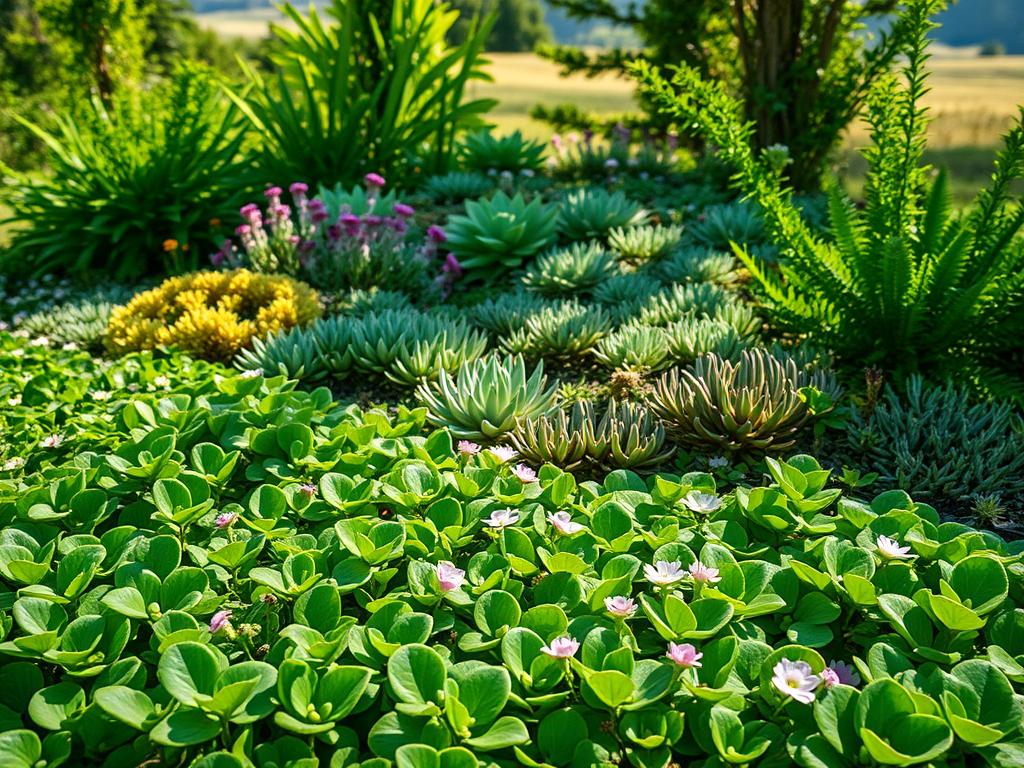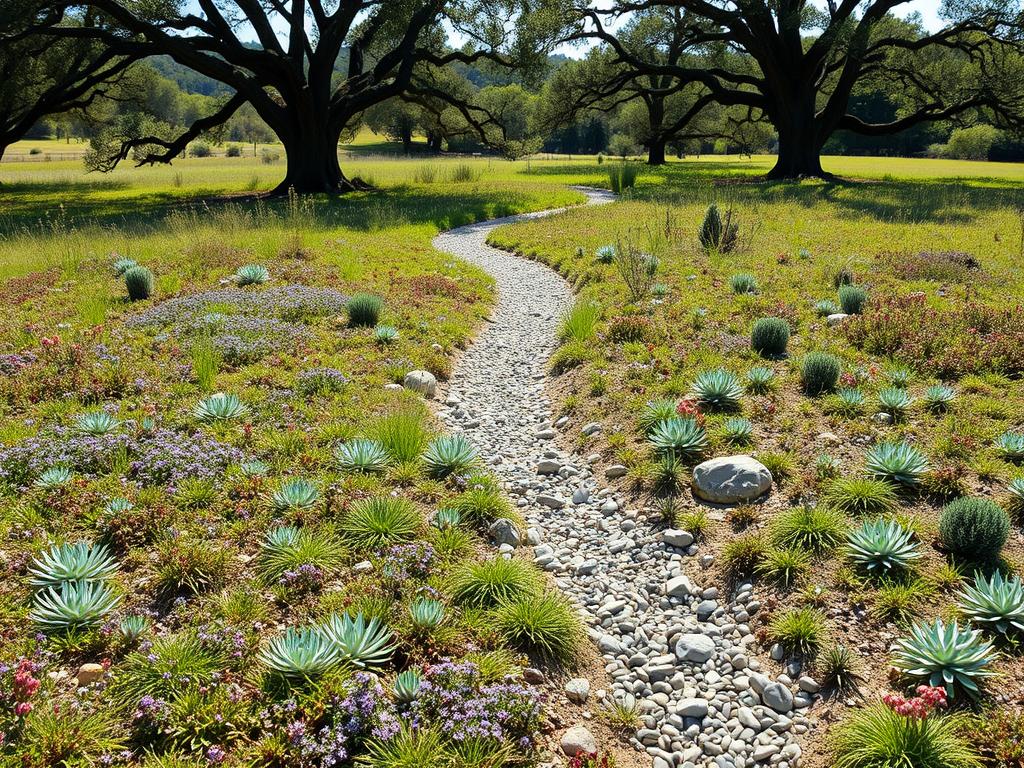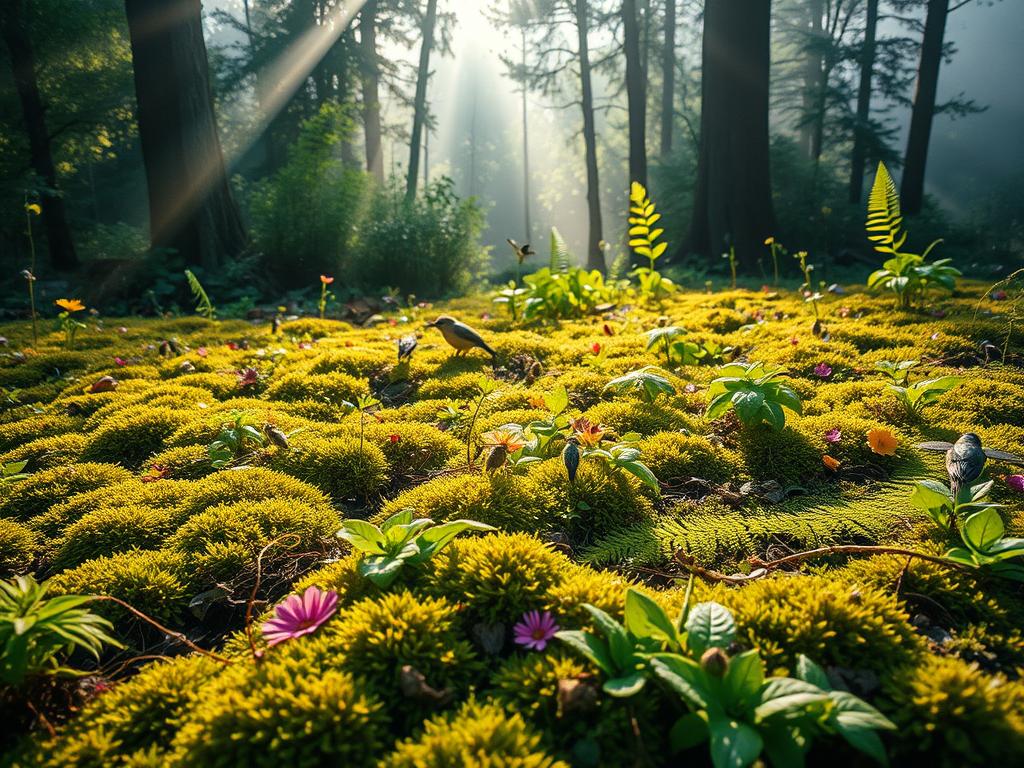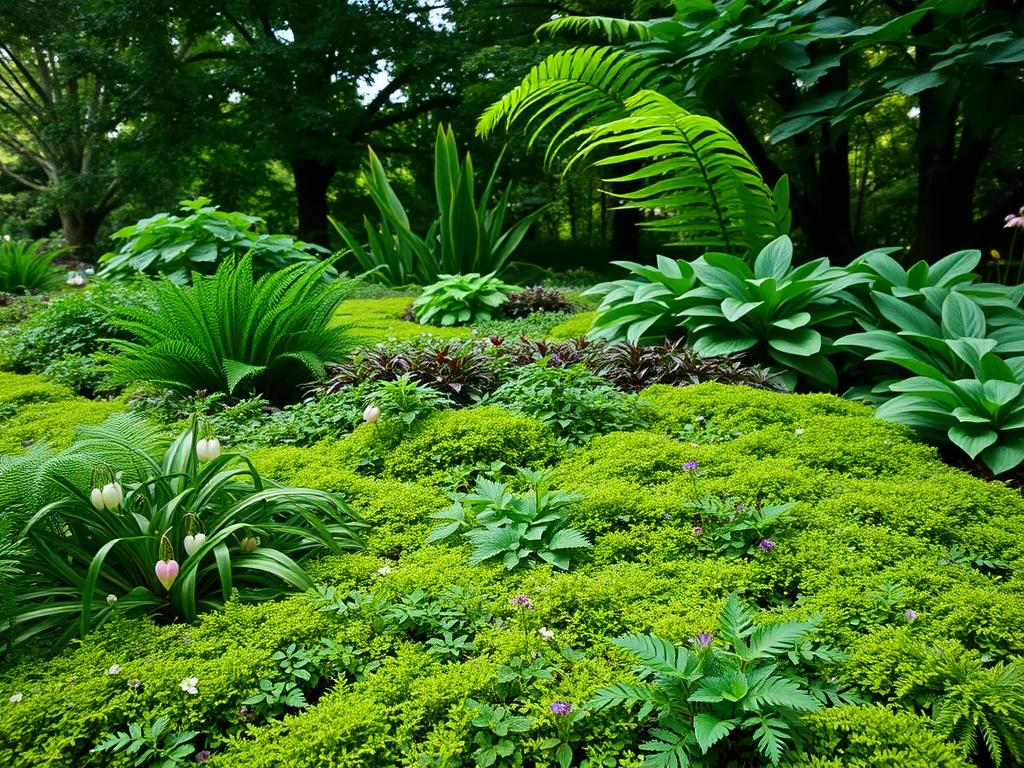
The Best Low-Maintenance Ground Cover Plants for Small Gardens
Are you struggling to maintain a lush garden in your small outdoor space? Low-maintenance gardening is a growing trend, and for good reason. With the right plants, you can enjoy a beautiful garden without the hassle of constant upkeep.
Efficient gardening solutions like low-maintenance ground cover plants can transform your small garden into a vibrant oasis. These plants are perfect for filling gaps between pavers, suppressing weeds, and adding color to your garden.
By choosing the right ground cover plants, you can create a stunning and sustainable garden that requires minimal care. In this article, we’ll explore the best options for your small garden.
Understanding Ground Cover Plants
Ground cover plants are an essential element in landscaping, offering both aesthetic and functional benefits. These plants are used to cover areas of the ground, providing a uniform appearance and reducing the need for mulch or other ground coverings.
What Are Ground Cover Plants?
Ground cover plants are low-growing plants that spread out to cover the soil. They can be used in various settings, from gardens and landscapes to slopes and areas where other plants may struggle to grow. Native ground cover plants are particularly beneficial as they are adapted to the local climate and soil conditions, requiring less maintenance.
Benefits of Using Ground Cover
The use of ground cover plants offers several benefits, including:
- Reduced soil erosion
- Weed suppression
- Aesthetic appeal with varied textures and colors
- Low maintenance requirements
Landscaping ground cover can also help in reducing the need for frequent mowing and watering, making it a practical choice for busy homeowners.
Types of Ground Cover Plants
There are numerous types of ground cover plants, each with its unique characteristics and benefits. Some popular options include:
| Type | Description | Benefits |
|---|---|---|
| Creeping Thyme | A low-growing, spreading plant with fragrant leaves | Attractive, drought-tolerant, and weed-suppressing |
| Sedum | A succulent that stores water in its leaves | Drought-resistant and versatile |
| Ajuga | A fast-spreading plant with colorful foliage | Provides vibrant colors and textures |
Choosing the Right Ground Cover for Your Garden
The right ground cover can transform your garden, but it requires careful consideration of various elements. Ground cover plants are not just aesthetically pleasing; they also play a crucial role in maintaining soil health and reducing maintenance needs.
Factors to Consider
When selecting a ground cover, several factors come into play. These include the type of soil, the amount of sunlight your garden receives, and the climate of your area.
Soil Type: Different ground covers thrive in different soil types. For instance, some plants prefer well-drained soil, while others can tolerate clay or sandy soils.
Sunlight: The amount of sunlight is crucial. Some ground covers are ideal for shaded areas, while others require full sun to thrive.
Assessing Soil Type and Sunlight
To choose the right ground cover, it’s essential to assess your garden’s soil type and sunlight exposure.
- For shaded areas, consider ground covers like Pachysandra or Vinca Minor.
- For sunny spots, Lantana or Dianthus can be excellent choices.
Understanding these conditions will help you narrow down the most suitable options for your garden.
Seasonal Considerations
Seasonal changes can significantly impact your ground cover’s performance. Some plants may go dormant during winter, while others may bloom in specific seasons.
| Season | Considerations | Example Plants |
|---|---|---|
| Spring | Many ground covers bloom in spring, adding color to your garden. | Creeping Thyme, Ajuga |
| Summer | Some ground covers continue to bloom, while others may require more watering. | Lantana, Sedum |
| Fall/Autumn | Foliage changes can add autumn colors, and some plants may start to go dormant. | Dianthus, Vinca Minor |
By considering these factors and understanding your garden’s specific needs, you can choose a ground cover that not only thrives but also enhances your garden’s beauty throughout the year.
Popular Ground Cover Varieties for Small Gardens
In the realm of small gardens, popular ground cover varieties can transform outdoor spaces into lush, vibrant areas. These plants not only add beauty but also offer practical benefits such as weed suppression and soil erosion control.
Creeping Thyme: Aromatic and Resilient
Creeping thyme is a favorite among gardeners due to its aromatic foliage and resilience. It thrives in well-drained soil and full sun, making it ideal for areas that receive plenty of sunlight. This evergreen ground cover is also drought-tolerant, requiring less watering.
Key Features:
- Aromatic foliage
- Drought-tolerant
- Evergreen
Sedum: Drought-Resistant and Versatile
Sedum is another popular choice for ground cover, known for its drought resistance and versatility. It comes in various shapes and sizes, from low-growing spreading varieties to taller, more upright forms. Sedum is perfect for areas with poor soil and full sun.
Benefits:
- Low maintenance
- Variety of forms
- Drought-resistant
Ajuga: Colorful Foliage and Flowers
Ajuga, or bugleweed, is a versatile ground cover that offers colorful foliage and flowers. It prefers moist, well-drained soil and partial shade, making it suitable for areas under trees or in shaded garden beds. Ajuga is also known for its rapid spread, helping to cover large areas quickly.
| Plant | Sunlight Preference | Watering Needs | Spread Rate |
|---|---|---|---|
| Creeping Thyme | Full Sun | Low | Moderate |
| Sedum | Full Sun | Low | Slow to Moderate |
| Ajuga | Partial Shade | Moderate | Fast |
By choosing the right ground cover for your small garden, you can enjoy a beautiful, low-maintenance outdoor space that enhances your home’s appeal.
Low-Maintenance Ground Covers for Sunlight
When it comes to sunny spots, certain ground covers stand out for their ability to flourish with minimal upkeep. These plants are perfect for areas that receive full sun, transforming your garden into a vibrant and resilient space.
Lantana: Bright Blooms in Sunny Spots
Lantana is a popular choice for sunny areas due to its bright, clustered blooms and its ability to attract butterflies and other pollinators. It is drought-tolerant and requires minimal care, making it an ideal ground cover for slopes and dry areas.
Dianthus: Hardy and Attractive in Full Sun
Dianthus, also known as carnations, are hardy plants that thrive in full sun. They offer a variety of colors and are known for their fragrant flowers. Dianthus is relatively low maintenance and can tolerate some drought, making it a great option for sunny gardens.
Stonecrop: Ideal for Rocky Areas
Stonecrop, or sedum, is a versatile ground cover that excels in rocky areas and full sun. It comes in various shapes and sizes, from low-growing spreading varieties to taller, upright forms. Stonecrop is highly drought-tolerant and requires little care, making it perfect for challenging garden spots.
The following table summarizes the key characteristics of these ground covers:
| Plant | Sun Tolerance | Drought Tolerance | Maintenance Level |
|---|---|---|---|
| Lantana | High | High | Low |
| Dianthus | High | Medium | Low |
| Stonecrop | High | High | Low |

Ground Covers for Shady Areas
Shade-loving ground covers provide an excellent opportunity to add texture and color to less sunny parts of your garden. These plants are not only aesthetically pleasing but also offer a low-maintenance solution for areas where other plants might struggle to thrive.
Pachysandra: A Shade Lover’s Favorite
Pachysandra is a popular choice for shady areas due to its glossy, dark green leaves and ability to form a dense, weed-suppressing mat. It prefers well-drained soil and partial to full shade.
Vinca Minor: Trailing Periwinkle
Vinca minor, or periwinkle, is another excellent ground cover for shaded areas. It has trailing stems with blue-purple flowers in the spring and can form a dense cover that suppresses weeds.
Clarke’s Bluebell: Delicate Beauty in Shade
Clarke’s Bluebell is a charming ground cover that thrives in shady conditions, producing delicate, bell-shaped flowers. It is ideal for woodland gardens or under trees where its beauty can be appreciated.
| Ground Cover | Shade Tolerance | Maintenance Level | Flower Color |
|---|---|---|---|
| Pachysandra | High | Low | Insignificant |
| Vinca Minor | High | Low | Blue/Purple |
| Clarke’s Bluebell | High | Low to Medium | Blue |
These ground covers offer a range of options for shady areas, from the dense, evergreen foliage of Pachysandra to the flowering beauty of Clarke’s Bluebell. By choosing the right ground cover, you can enhance the visual appeal of your garden’s shaded areas.
The Role of Ground Covers in Eco-Friendly Gardening
In the realm of eco-friendly gardening, ground covers emerge as a versatile and sustainable solution. Ground covers are not just aesthetically pleasing; they also contribute significantly to environmental conservation.
Erosion Control is a critical benefit of using ground covers. By stabilizing the soil, ground covers prevent erosion caused by wind or water runoff. This is particularly important in areas with heavy rainfall or where soil quality is poor.
Erosion Control: Protecting Your Soil
Ground covers like Creeping Thyme and Sedum have deep roots that hold the soil in place, reducing the risk of erosion. This not only protects the soil but also prevents sedimentation in water bodies.
| Ground Cover Type | Erosion Control Effectiveness | Maintenance Needs |
|---|---|---|
| Creeping Thyme | High | Low |
| Sedum | High | Low |
| Vinca Minor | Medium | Moderate |
Biodiversity: Supporting Local Wildlife
Ground covers also play a crucial role in supporting local biodiversity. By providing habitat and food for various species, they contribute to a healthier ecosystem.

For instance, flowering ground covers like Lantana attract pollinators, while dense covers like Pachysandra provide shelter for small animals.
Water Conservation Benefits
Another significant advantage of ground covers is their ability to conserve water. By reducing soil exposure and retaining moisture, they minimize the need for frequent watering.
Low-maintenance ground covers such as Stonecrop are particularly effective in water conservation, making them ideal for dry or drought-prone areas.
Ground Cover in Urban Gardens
In urban settings, ground cover proves to be an invaluable asset for gardeners looking to maximize their green spaces. Urban gardens often face challenges such as limited space and harsh conditions, but ground cover plants can mitigate these issues effectively.
One of the primary benefits of using ground cover in urban gardens is their ability to enhance small spaces with greenery. By covering bare ground, these plants can transform neglected areas into vibrant, lush spaces.
Enhancing Small Spaces with Greenery
Urban dwellers often have limited space for gardening, but best ground cover plants can turn even the smallest areas into thriving gardens. For instance, creeping thyme or sedum can be used to create a lush carpet that requires minimal maintenance.
These plants not only add visual appeal but also help in reducing soil erosion and improving air quality. Moreover, they can be used to create pathways, borders, or even decorative patterns within the garden.
Container Options for Limited Areas
For urban gardens with extremely limited space, using evergreen ground cover in containers is a viable option. Containers can be placed on balconies, rooftops, or even indoors, allowing for flexibility in garden design.
When choosing containers, it’s essential to select plants that thrive in confined spaces and can tolerate the local climate. Pachysandra or Vinca minor are excellent choices for shaded areas, while Lantana or Dianthus can flourish in sunny spots.
By incorporating ground cover into urban gardens, either directly in the ground or in containers, city dwellers can enjoy a more verdant and inviting outdoor space. This not only enhances the aesthetic appeal of the area but also contributes to a healthier urban environment.
Maintenance Tips for Ground Cover Plants
The key to a lush, vibrant ground cover lies in proper maintenance techniques. Ground cover plants are renowned for their hardiness and low-maintenance requirements, but they still need some care to thrive.
Watering: Finding the Right Balance
Watering is a critical aspect of ground cover maintenance. Drought-tolerant ground covers require less water, but they still need occasional watering, especially during prolonged dry spells. Overwatering can be detrimental, leading to root rot and other issues.
A general rule is to water them deeply but infrequently to encourage deep root growth. The frequency of watering will depend on the type of ground cover, soil type, and climate.
Pruning and Trimming for Health
Pruning and trimming are essential for maintaining the health and appearance of your ground cover. Regular pruning helps control the spread, promotes healthy growth, and encourages denser foliage.
For flowering ground covers, pruning after they finish blooming can help maintain their appearance and promote new flowers. Use the right tools for pruning to avoid damaging the plants.
Dealing with Weeds Effectively
Weeds can be a significant problem for ground cover plants, competing with them for water, nutrients, and light. Mulching can help suppress weeds by blocking light and preventing seed germination.
Regularly inspecting your ground cover and manually removing weeds is also effective. Using a pre-emergent herbicide can prevent weeds from germinating, but be cautious with its application to avoid harming your ground cover.
| Maintenance Task | Frequency | Tips |
|---|---|---|
| Watering | Depends on climate and soil | Water deeply but infrequently |
| Pruning/Trimming | Regularly, after blooming | Use right tools, promote healthy growth |
| Weed Control | Ongoing | Mulch, manual removal, pre-emergent herbicides |

Creating a Colorful Ground Cover Landscape
Creating a vibrant ground cover landscape is an art that combines different plants, textures, and colors. By carefully selecting and combining various ground cover plants, you can achieve a visually appealing and dynamic landscape that changes with the seasons.
Combining Different Plants for Visual Impact
To create a visually impactful ground cover, it’s essential to combine plants with different textures, heights, and colors. For instance, pairing the delicate, fern-like foliage of Artemisia with the bold, succulent leaves of Sedum can create a striking contrast. Similarly, mixing plants with different growth habits, such as the spreading Creeping Thyme and the upright Dianthus, adds depth and interest to the landscape.
Tips for Combining Plants:
- Choose plants with complementary colors and textures.
- Consider the mature size of each plant to ensure a harmonious arrangement.
- Mix plants with different growth rates to maintain a dynamic landscape.
Seasonal Blooms and Foliage Color
Incorporating plants with seasonal blooms and varying foliage colors can keep your ground cover landscape interesting throughout the year. For example, Lantana provides bright blooms in the summer, while Ajuga offers colorful foliage year-round. By selecting a mix of plants with different bloom times and foliage characteristics, you can create a constantly evolving display.
| Plant | Seasonal Interest | Foliage Color |
|---|---|---|
| Lantana | Summer blooms | Green |
| Ajuga | Spring blooms | Variegated |
| Sedum | Late summer blooms | Blue-green |
By thoughtfully combining different ground cover plants and considering their seasonal interest, you can create a beautiful and dynamic landscape. For more inspiration, consider exploring native ground cover plants, which are often well-suited to local conditions and can add unique character to your garden.
DIY: Planting Ground Cover in Your Garden
With the right timing and techniques, establishing ground cover in your garden can be a rewarding experience. Ground cover plants are versatile and can thrive in various conditions, including shaded areas and challenging soil types.
Best Time for Planting
The best time to plant ground cover depends on the type of plant and your location. Generally, spring and fall are considered ideal because the weather is mild, and there is ample moisture in the soil. For evergreen ground cover, these seasons allow the plants to establish themselves before the extreme temperatures of summer or winter.
| Season | Advantages | Disadvantages |
|---|---|---|
| Spring | Mild weather, ample moisture | Potential for late frosts |
| Fall | Cooler temperatures, less watering needed | Possible onset of winter before establishment |
| Summer | Active growth period | High temperatures, increased watering needs |
Steps for Successful Planting
To ensure the successful establishment of ground cover, follow these steps:
- Prepare the soil by removing weeds and loosening it to a depth of about 8-10 inches.
- Choose healthy plants with vigorous growth, suitable for your climate and soil type.
- Space the plants according to their spread; some ground cover plants can spread quickly, while others may need closer spacing.
- Water thoroughly after planting and keep the soil consistently moist during the first growing season.
- Apply a layer of mulch to retain moisture and suppress weeds.

Common Mistakes to Avoid
Avoid common mistakes such as not preparing the soil properly, planting at the wrong time, or not providing adequate care after planting. Overwatering can be detrimental, as can neglecting to control weeds that compete with your ground cover for water and nutrients.
Ground Cover vs. Traditional Lawns
Ground cover and traditional lawns are two popular landscaping options that cater to different needs and preferences. While traditional lawns have been a staple in many gardens, ground cover is gaining popularity due to its numerous benefits.
One of the primary considerations when deciding between ground cover and traditional lawns is the cost-effectiveness and maintenance required. Ground cover is often touted as a low-maintenance alternative to traditional lawns, requiring less watering, mowing, and fertilizing.
Cost-Effectiveness and Maintenance
Ground cover plants are generally more cost-effective in the long run. They require less frequent watering, mowing, and fertilizing compared to traditional lawns. Here are some key benefits:
- Reduced water consumption
- Less need for mowing and trimming
- Fewer fertilizers and pesticides required
In contrast, traditional lawns demand regular maintenance, including mowing, watering, and fertilizing, which can be time-consuming and costly.
Aesthetic Differences and Benefits
Ground cover and traditional lawns also differ significantly in terms of aesthetics. Ground cover offers a diverse range of textures, colors, and patterns, allowing for a more varied and interesting landscape design.
Some popular ground cover options include:
- Creeping thyme, which provides a fragrant and dense cover
- Sedum, known for its drought resistance and versatility
- Ajuga, offering colorful foliage and flowers
Traditional lawns, while classic and timeless, can be limited in their aesthetic appeal. Ground cover, on the other hand, can be tailored to suit different garden styles and themes, making it a versatile choice for landscaping.
In conclusion, when choosing between ground cover and traditional lawns, it’s essential to consider factors such as cost-effectiveness, maintenance, and aesthetic appeal. Ground cover emerges as a highly adaptable and low-maintenance option, suitable for a variety of gardening needs.
Conclusion: Transforming Your Garden with Ground Cover
Ground cover plants offer a versatile and low-maintenance solution for enhancing your garden’s beauty and functionality. By understanding the different types of ground cover and their benefits, you can create a stunning landscape that requires minimal upkeep.
Key Takeaways
The best ground cover plants can thrive in various conditions, from sunny spots to shady areas. Native ground cover plants are particularly beneficial, as they support local biodiversity and are adapted to the local climate. Whether you’re looking to suppress weeds, prevent erosion, or add color to your garden, there’s a ground cover solution to suit your needs.
Starting Your Gardening Journey
As you embark on your gardening journey, consider the potential of ground cover to transform your outdoor space. With the right selection and maintenance, ground cover can provide a beautiful, sustainable, and eco-friendly alternative to traditional lawns. Explore the many options available, and enjoy the process of creating a unique and captivating garden that reflects your personal style.
Leave a Reply